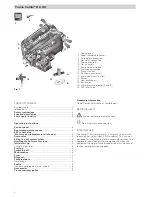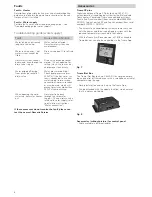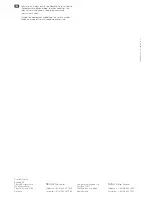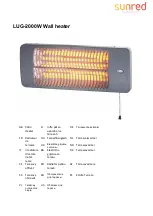
6
Drain valve
The drain valve automatically equalises the pressure in the
event of overpressure in the system. When this occurs, the
water is drained to the outside in intermittent bursts via a
drainage socket.
This drain valve does not protect the water container
from
frost damage.
c
b
a
d
Fig. 4
a = Lever in position “Operational – closed”
b = Lever in position “Operational – closed”
c = Lever in position “Drain”
d = Drainage socket (led outside through floor of vehicle)
Opening the drain valve
– Move lever to position (c) – vertical. The water from the hot
water system drains through the drainage socket (d).
The drainage socket (d) of the drain valve must be free of
blockages (slush, ice, leaves, etc.) at all times so the water
can drain easily!
No warranty claims for frost damage
will be accepted.
Closing the drain valve
– Move lever to position (a) or (b) – horizontal.
Filling the hot water system
Check whether the drain valve is closed (see “Closing the
drain valve”).
– Switch on the power for the water pump (main switch or
pump switch).
– Open hot water taps in kitchen and bathroom, (set prese-
lecting mixing taps or single-lever fittings to “hot”). Leave
the fittings open for as long as it takes for the hot water
system to displace the air and fill up and the water to flow
without interruption.
If only the cold water system is being operated without
the hot water system, the hot water system also fills up
with water. To avoid frost damage, the hot water system
must be drained via the drain valve, even if it was not
operated.
In the event of frost, filling may be prevented by residual wa-
ter that has frozen. The hot water system can be thawed out
again by briefly starting it up (max. 2 minutes). Frozen lines
can be thawed out by heating up the interior.
If connected to a central water supply (rural or urban
connection), a pressure reducer must be used, which
will prevent pressures of greater than 280 kPa from occurring
in the hot water system.
Draining the hot water system
– Switch off the power for the water pump (either by the main
switch or the pump switch).
– Open hot water taps in kitchen and bathroom.
– Open drain valve:
Lever in vertical position, position (m).
The hot water system is now drained directly to the outside
via the drain valve. Place a bucket beneath the outlet to check
whether the water has completely drained away (10 litres).
There shall be no claims under guarantee for damage
caused by frost!
Initial start-up
(or when the fuel tank has run empty)
Filling the fuel lines
The heater normally has to be started up several times to fill
the fuel lines.
Connect unit to control panel to do this. The unit automati-
cally performs 2 start attempts (initial start and repeat) per
switch-on procedure with a run time of 2 minutes in each
case. If no flame is detected after the repeat start, the unit
switches to fault and has to be switched off and on again at
the control panel.
After a total of 15 unsuccessful starting attempts (initial
and repeat start) without forming a flame, the equipment
is blocked. To remove the block, please contact the Dometic
Service Centre (see www.truma.com).
Check fuel lines and connections for leaks after filling the fuel
lines.
Start-up
The interior can be heated with or without water, depending
on the setting.
– Check to make sure the cowl is unobstructed. Remove any
covers that may be present.
– Fill the hot water system with water if necessary (see “Fill-
ing the hot water system”).
– Switch on the unit on the control panel.
Switching off
– Switch the heater off on the control panel.
– The switch-off procedure may be delayed by several min-
utes because of internal heater operations.
Always drain water if there is a risk of frost!
Summary of Contents for Combi D 6 AU
Page 1: ...Operating instructions Page 2 To be kept in the vehicle Truma Combi D 6 AU...
Page 10: ...Notes...
Page 11: ...Notes...






























